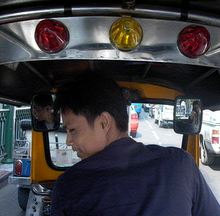Jakarta Post, Opinion and Editorial, March 18, 2006
When was the last time you were in a public space in Jakarta? If you don't use public transportation and hardly walk or bike on the streets of Jakarta, you might start thinking about malls, dining places or other entertainment places inside offices, hotels and other commercial complexes. Or you might think about parks, sports facilities, or other public areas including the streets inside your housing or apartment complexes.
You may want to think again, because all of these places may not be true public spaces, in the sense that they are not accessible to everyone. In other words, most malls, offices, hotels and other commercial complexes are privatized public spaces. Even when you spend hours of your time on Jakarta's congested streets inside your car -- you are in private property in a public space.
True public space in Jakarta is rarely frequented by members of the upper (or middle) class, while privatized public space is exclusive. The result, I am afraid, is further demarcation between the upper and lower classes of Jakarta.
Bestuzhev-Lada categorizes public space for leisure activities as "places for contemplation (religious buildings, parks, embankments), places to obtain new information (museums, libraries, exhibitions), places for creative activities (clubs, daily centers, etc.), places for sports activities (stadiums, sports centers), places for entertainment (dancing/concert halls, theaters), and places where public holidays are celebrated (squares, streets)" (Bestuzhev-Lada, 1972, in Gabidulina, 1994). Nowadays, it is questionable which of these places have remained true public space, as some, if not most of them, have been privatized.
What makes a public space privatized? Margaret Crawford reveals that the designs of most malls attempt to "create essentially a fantasy urbanism devoid of the city's negative aspects: weather, traffic, and poor people". She adds that malls are heavily patrolled to ensure safety of their homogeneous clientele by exclusion of others (Crawford, 1992).
Trevor Boddy, in arguing against privatized skyways, specifies that "two forms of policing kept the skyway system a haven of middle-class propriety: formal, by police officers at key entrance stairs and security guards in lobbies, and informal, through the visual codes and cues indicating that anyone not dressed appropriately or behaving in an acceptable manner is unwelcome" (Boddy, 1992).
The fast growth of malls in Jakarta after 1998 is linked by Abidin Kusno with "looseness" of power which triggers the feeling of insecurity among the formerly protected upper-middle class of Jakarta (Kusno, 2004). Malls have become safe havens for the upper-middle class, and I would include all privatized public space in this category.
Even when the upper (and some middle) class leave home (inside a housing or apartment complex), they are most likely moving around Jakarta in a private car, going from one private property to another without being part of public space. Being in the car, they are physically separated and psychologically removed from the activities and the people on the street by sheets of tempered glass and galvanized metals.
The car windows become screens though which the city is passively viewed, rather than a space in which we can actively participate. The city, the streets and the people outside become images, not too different perhaps from what we have seen on other screens like computers, televisions, movies. The public space is seen and experienced as visual stimuli -- the unwanted aspects we can both consciously and unconsciously filter or ignore.
Children from upper (and some middle) class who are born post-1998 are most likely growing up within homogeneous communities. They could become unaware of, insensitive toward and immune to lower-middle classes that are excluded from places they encounter in their daily lives. Nowadays in Jakarta, the only possibility for interaction among different socioeconomic groups of children are organized by schools under the umbrella of community work.
The way we design, use and experience Jakarta's public space has remarkably influenced our social interactions, and will surely have social implications. If we maintain the present conditions, we can only imagine the effect on the growing class division.
Subscribe to:
Post Comments (Atom)




No comments:
Post a Comment